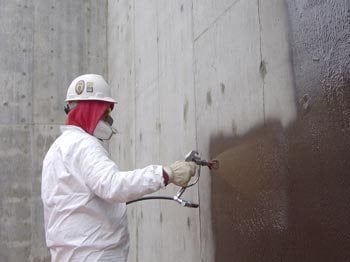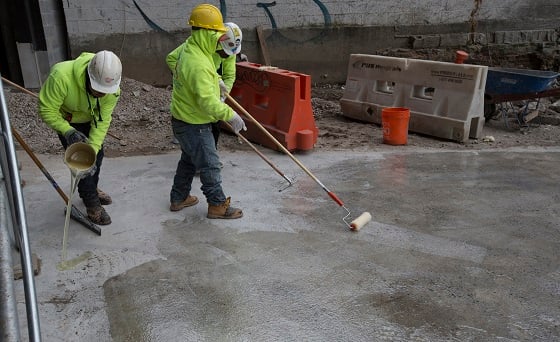The Risks of Ignoring Water Solutions in Your Home
The Risks of Ignoring Water Solutions in Your Home
Blog Article

All About Waterproofing: Understanding Its Relevance and Advantages for Your Home
Waterproofing is a crucial element of home maintenance that lots of house owners forget. It serves to shield structures from the destructive impacts of water infiltration, which can bring about substantial problems gradually. Recognizing the different approaches and their significance can assist property owners make informed choices. As the conversation unravels, the actual inquiry stays: just how can efficient waterproofing transform a home's strength against moisture-related hazards?
What Is Waterproofing and How Does It Work?
Waterproofing is an important procedure created to shield structures and structures from water infiltration. It includes the application of numerous products and strategies that develop an obstacle, avoiding water from permeating surfaces. Common waterproofing approaches consist of using membrane layers, finishings, and sealants, which can be related to roofs, structures, and wall surfaces. Each approach is chosen based upon the particular needs and problems of the structure.The effectiveness of waterproofing depends on correct setup, ensuring that all areas are effectively covered and secured. Materials such as bituminous membranes, fluid waterproofing compounds, and cementitious coatings are regularly employed, each offering one-of-a-kind benefits. Additionally, water drainage systems may be incorporated to redirect water far from prone areas, better improving security. Overall, waterproofing not just safeguards structural honesty yet also improves longevity, making it a crucial consideration in building and construction and restoration jobs.
The Value of Waterproofing for House owners
Homeowners deal with various challenges in preserving their properties, and among one of the most substantial problems is water damages. This concern can emerge from numerous resources, consisting of heavy rainfall, flooding, and plumbing failings. When left unaddressed, water damages can result in extreme structural issues, mold growth, and costly repair services. Waterproofing stands as an essential precautionary action that safeguards homes from these prospective threats.
Common Waterproofing Approaches and Strategies
When thinking about waterproofing approaches, house owners can pick from a range of efficient options. Outside waterproofing remedies concentrate on preventing water from passing through the framework, while indoor waterproofing strategies attend to wetness problems once they have occurred. Understanding these alternatives is essential for preserving a completely dry and healthy and balanced home setting.
Outside Waterproofing Solutions
To protect a home from water breach, various exterior waterproofing solutions can be used, each customized to the details demands of the structure. One usual method is the application of water-proof membrane layers, which produce an obstacle against wetness. These membrane layers can be either liquid-applied or sheet-based, depending on the installation requirements. One more reliable strategy includes the usage of drain systems, such as French drains pipes, that redirect water away from the foundation. Additionally, applying exterior sealers can help safeguard surface areas from water penetration and rust. Landscaping solutions, including grading and correct water drainage, can also add notably to avoid water build-up around the foundation. Each of these approaches plays an important duty in enhancing the long life and longevity of the building.
Inside Waterproofing Techniques
Inside waterproofing strategies are vital for guarding a home versus moisture and water damage. Common approaches consist of the application of sealants and membrane layers, which produce an obstacle on wall surfaces and floorings to avoid water seepage. Inside drain systems, such as sump pumps and French drains pipes, efficiently redirect water far from prone areas. Furthermore, vapor obstacles can be installed to block moisture from penetrating through wall surfaces and floorings, particularly in cellars and creep rooms (Water Solutions). Routine maintenance and examination of these systems are necessary to guarantee their efficiency. Addressing any type of plumbing leakages or condensation issues promptly can substantially enhance the general waterproofing method. With each other, these techniques give house owners with a comprehensive strategy to decreasing the threat of water-related troubles

Signs Your Home Demands Waterproofing
Home owners should understand essential signs that their residential or commercial property may call for waterproofing. Noticeable water damage, musty odors, and regular mold development are vital indicators that dampness is compromising the integrity of the home. Resolving these issues immediately can stop more damages and ensure a much healthier living atmosphere.
Visible Water Damages
Visible water damage functions as a clear indication that a home may call for waterproofing steps. Homeowners need to be alert for indications such as water stains on walls or ceilings, peeling off paint, and warped floor covering. These visible signs and symptoms often represent underlying wetness issues that, if left unaddressed, can bring about more comprehensive damage and costly repair work. Mold and mildew development can likewise happen, though it will be talked about in the following section. In addition, house owners ought to evaluate cellars and crawl areas for moisture or efflorescence on concrete surface areas, which suggests moisture penetration. Discovering these indicators early can aid prevent even more wear and tear of the home's architectural stability. Prompt waterproofing procedures can guard the financial investment and keep a healthy and balanced living environment.
Musty Odors Existing
Moldy odors are typically a warning indication that wetness is sticking around in hidden locations of click to find out more a home, showing the requirement for waterproofing solutions. These undesirable scents frequently develop from wet basements, crawl spaces, or behind walls, where water infiltration may not be instantly noticeable - Sump pump installation & replacement Omaha. Home owners ought to pay close focus to these smells, as they recommend that excess humidity is caught, possibly leading to more damages. The visibility of moldy smells can jeopardize interior air quality, affecting the wellness and comfort of residents. Ignoring this advising indicator can result in extra severe issues, making prompt analysis and activity important. By dealing with waterproofing requirements, property owners can get rid of moldy odors and develop a much healthier living environment
Frequent Mold And Mildew Growth
Regular mold development is a clear sign that a home may be experiencing dampness issues, requiring waterproofing measures. Mold and mildew flourishes in damp environments, making it a considerable worry for house owners. Indications of mold can consist of dark places on wall surfaces, ceilings, and around home windows, along with a persistent mildewy scent. If mold and mildew shows up continuously regardless of cleaning efforts, it recommends underlying moisture issues. This can arise from leaks, insufficient drain, or high humidity levels. Disregarding these indications can result in architectural damage and health risks, particularly for individuals with breathing problems. Consequently, attending to waterproofing immediately can assist minimize mold and mildew development, guaranteeing a much safer and healthier living environment. House owners ought to take into consideration professional evaluations to determine the extent of the moisture problem.
The Long-Term Benefits of Purchasing Waterproofing
Purchasing waterproofing uses homeowners an extensive complacency and peace of mind, recognizing their building is protected versus moisture-related damage. This positive approach greatly minimizes the threat of architectural concerns, such as wood rot and foundation fractures, which can result in pricey repairs gradually. Furthermore, waterproofing helps maintain interior air quality by lessening mold development, which can have negative health and wellness effects for occupants.Furthermore, waterproofing improves the sturdiness of a home, inevitably protecting its worth. A well-protected home is a lot more eye-catching to possible buyers, as they are less most likely to run into surprise moisture troubles. This financial investment likewise adds to energy performance; properly sealed spaces stop drafts and minimize cooling and heating prices. Generally, the lasting benefits of waterproofing not only guarantee the structural integrity of a home but additionally cultivate a healthier living setting and reinforce the residential property's bankability.
Choosing the Right Waterproofing Professional for Your Home
Just how can a home owner assurance they choose one of the most certified waterproofing specialist for their requirements? The procedure starts with comprehensive research and obtaining several quotes. Property owners need to look for experts with a strong track record, verified qualifications, and considerable experience in waterproofing. Inspecting on the internet evaluations and requesting for referrals can give important insight into a professional's dependability and top quality of work.Moreover, it is vital to inquire concerning the details waterproofing methods each professional utilizes, as well as the materials utilized. Home owners must confirm that the picked specialist is licensed and insured, Visit Website which protects against possible obligations. A trustworthy specialist will likewise supply an in-depth agreement laying out the scope of work, timeline, and guarantee info. By focusing on these criteria, homeowners can make enlightened choices, ultimately leading to improved protection versus water damages and an efficient waterproofing service customized to their home's needs.
Often Asked Concerns
Can Waterproofing Be Performed In Winter or Cold Climate?
Waterproofing can be testing throughout wintertime or winter as a result of reduced temperature levels impacting materials' bond and curing processes. Specialized items developed for cold problems can make it possible for effective waterproofing applications even in winter months.
How Usually Should I Waterproof My Home?
The regularity of waterproofing a home typically relies on different variables, including climate and material high quality. Specialists recommend reviewing conditions every year and reapplying every 5 to 10 years, or sooner if significant wear appears.
Does Waterproofing Affect Home Resale Value?
Waterproofing can significantly influence a home's resale value (Foundation waterproofing Omaha). Possible buyers frequently check out waterproofing as a secure against water damages and mold and mildew, raising the building's allure see this here and bankability, potentially causing higher offers and quicker sales
Is DIY Waterproofing Effective for All Houses?
The efficiency of DIY waterproofing differs by home. Elements such as building age, ecological problems, and existing damage influence results. Homeowners should analyze their particular conditions before attempting do it yourself options to assure long-term protection.

Are There Eco-Friendly Waterproofing Options Available?
Environmentally friendly waterproofing alternatives do exist, consisting of natural sealants like beeswax and plant-based items. These remedies decrease environmental effect while efficiently safeguarding structures from water damage, appealing to house owners seeking lasting options for their waterproofing requires.
Report this page